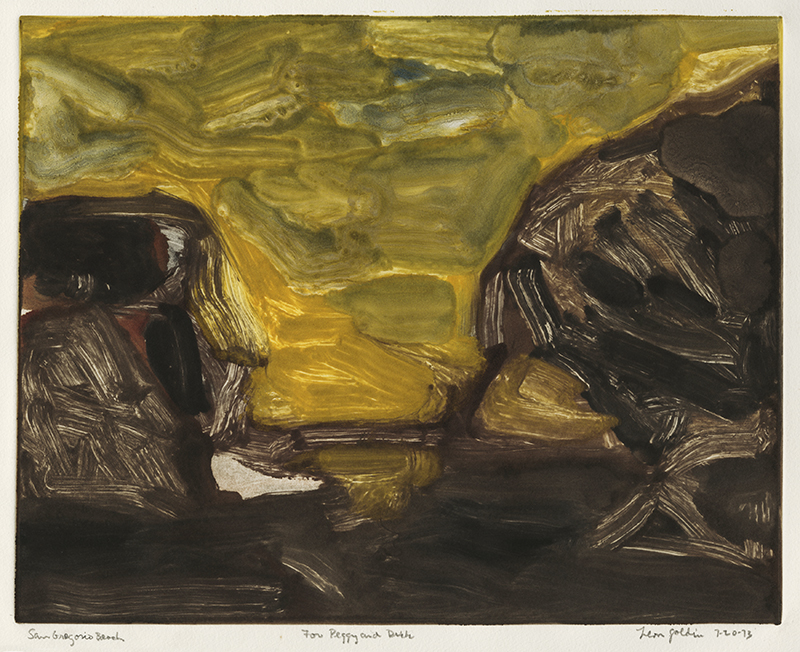San Gregorio Beach is a color monotype created in 1973 by American artist, Leon Goldin. It is pencil signed, titled, dated 7-20-73, and dedicated “For Peggy and Dick.” This is a unique work was printed by the artist on cream wove paper. The image measures 10-15/16 x 13-3/4 inches.
Leon Goldin was teaching in New York in 1973 when he returned to California and created this expressive color monotype of San Gregorio Beach. He gifted this monotype to his old friends from his Iowa days, Richard and Peggy Bowman. Goldin attacked his matrix with short, direct strokes. His application of dark yellow implies a foggy, filtered, stormy sunset whose light flows across the surface in a threatening way. San Gregorio Beach is an estuary south of Half Moon Bay, in San Mateo County, on the Northern California coast. The beach is part of the California State Park System and is sheltered by soaring cliffs. It has a wide sandy beach and the San Gregorio Creek widens to form a small freshwater lagoon in the park behind a sand berm, or barrier beach, which typically blocks the mouth of the creek.
Leon Goldin, painter, printmaker, and teacher, was born on 16 January 1923 in Chicago, Illinois. His first introduction to lithography was a course taught by Misch Kohn at Hull House in Chicago. In 1941, Goldin enrolled in the School of the Art Institute of Chicago where he studied under Francis Chapin. World War II interrupted his studies as he served in both the United States Air Corps and the Army.
Upon his discharge, Goldin returned to Chicago in 1946 and re-enrolled at the School of the Art Institute of Chicago under the GI Bill and earned his BFA. He then studied at the University of Iowa with renowned printmaking professor Mauricio Lasansky and received his MFA. In 1947, Una Johnson, curator at the Brooklyn Museum, invited Goldin to participate in what became the first annual National Print Exhibition.
Goldin began teaching printmaking at the California College of Arts and Crafts [CCAC] in Oakland, California in 1951. The following year he won the Fulbright Scholarship in Painting that allowed him to travel in France. He was included in the exhibition Young American Printmakers at the Museum of Modern Art in 1953. In the fall of 1954, Goldin resumed his printmaking courses at the CCAC.
In 1955, Goldin had a solo exhibition of his paintings at the Oakland Museum [now the Oakland Museum of California] and that same year he was awarded the prestigious Prix de Rome, which brought him to the American Academy in Rome for three years.
In 1958 Goldin returned from Italy and settled in New York supported by a Guggenheim Fellowship. He began teaching at Cooper Union in New York in 1961 and, in 1963 he taught drawing classes at Columbia University. The following year he was appointed associate professor at Columbia and continued to teach there until his retirement in 1992.
Goldin was elected an Associate of the National Academy of Design in 1991 and was elevated to full Academician in 1993. He was also the recipient of an award from the National Institute of Arts and Letters; the National Endowment for the Arts; and a Ford Foundation Purchase Prize. His work is represented in the collections of the Baltimore Museum of Art, Maryland; the Brooklyn Museum, New York; the Canton Museum of Art, Ohio; the National Academy of Design, New York; the Pennsylvania Academy of the Fine Arts, Philadelphia; the Rhode Island School of Design Museum, Providence; the Virginia Museum of Fine Arts, Richmond; the Farnsworth Art Museum, Rockland, Maine; the Rose Art Museum, Brandeis University, Waltham, Massachusetts; the National Gallery of Art and the Smithsonian American Art Museum, Washington, D.C.; and the Worcester Art Museum, Massachusetts.
Leon Goldin died on 30 January 2009 in New York City.



